by Baxter and Nina
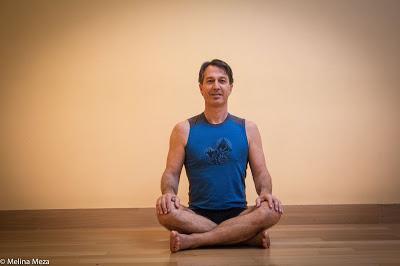 This extremely versatile pose allows you to sit comfortably on the ground for meditation, breath practices, and between other seated poses, and teaches you how to sit with good posture in your other seated yoga poses and in everyday life. In addition, the pose strengthens the back muscles needed to support your spine in a healthy position and stretches several of your hip muscles. The two variations of Easy Sitting pose with support make the pose accessible to almost everyone.
This extremely versatile pose allows you to sit comfortably on the ground for meditation, breath practices, and between other seated poses, and teaches you how to sit with good posture in your other seated yoga poses and in everyday life. In addition, the pose strengthens the back muscles needed to support your spine in a healthy position and stretches several of your hip muscles. The two variations of Easy Sitting pose with support make the pose accessible to almost everyone.Baxter prescribes this for:
- Weak spine and poor posture
- Tight hips
- Stress reduction
- Breath practice position
- Meditation position
- Resting position between other seated poses
Cautions: This is a generally a safe pose. But if you have knee pain or hip pain in the pose and you’ve tried all four versions of it, try Hero pose instead. And if you can’t get comfortable sitting on the ground for meditation or breath practice, sit on a chair instead.
1. Classic Version
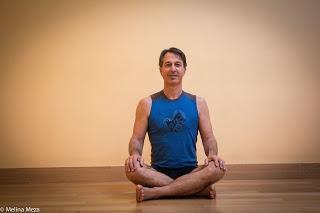 To come into the pose, sit on your mat with your legs stretched out in front of you and fingertips on the floor by your hips. Now, fold your legs into crossed-legs position with your right shin in front of your left, and your shins parallel with the front edge of your mat. Press your hands into the floor as you lengthen up from your sitting bones to the crown of your head, creating an “inner lift, ” and tip your hips a bit forward to encourage the normal curve of your lower back. Now, using your back and core muscles to maintain your inner lift, rest your hands on your knees, relax your should blades down, widen your collarbones, and align your head with your spine. Release your knees toward the floor, ideally below your top hipbones.
To come into the pose, sit on your mat with your legs stretched out in front of you and fingertips on the floor by your hips. Now, fold your legs into crossed-legs position with your right shin in front of your left, and your shins parallel with the front edge of your mat. Press your hands into the floor as you lengthen up from your sitting bones to the crown of your head, creating an “inner lift, ” and tip your hips a bit forward to encourage the normal curve of your lower back. Now, using your back and core muscles to maintain your inner lift, rest your hands on your knees, relax your should blades down, widen your collarbones, and align your head with your spine. Release your knees toward the floor, ideally below your top hipbones.Once you have settled in, keep your awareness on maintaining your inner lift. If you are meditating or doing a breath practice, you can start now. If not, bring your awareness to your breath.
To come out of the pose, place your fingertips on the floor by your hips for support, lean back slightly, and extend your legs out in front of you. If you have held the pose for 2 minutes or less, repeat the pose on the second side by changing the cross of your legs. Otherwise, alternate the cross of your legs from day to day.
2. Supported Hips and Knees
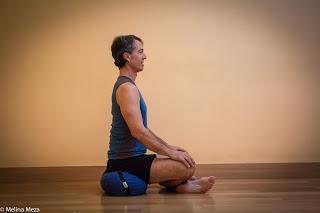
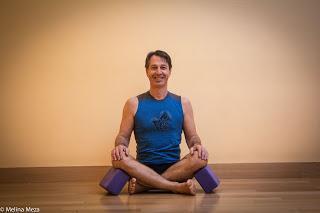 This variation is for anyone who cannot sit with good alignment in the classic pose. This includes people who cannot sit flat on the floor with their knees below the waist and/or who cannot maintain good posture with an inner lift without support.
This variation is for anyone who cannot sit with good alignment in the classic pose. This includes people who cannot sit flat on the floor with their knees below the waist and/or who cannot maintain good posture with an inner lift without support.To come into the pose, sit with your sitting bones near the front edge of your prop. (Experiment with with the height of the prop or blanket stack for your hips to find the height that allows you to experience the inner lift and spinal alignment described for classic version). Then place the blocks under your outer thighs so they fully support your thighs, using the height that allows you to relax your hip muscles and avoid any knee or hip pain.
Once you are comfortable, follow the instructions for the classic version for alignment and focus. To come out of the pose, remove the props supporting your thighs, and then follow the instructions for coming out of the classic version.
3. Back to the Wall
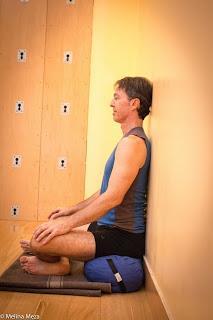 This variation provides support for anyone who has weak back muscles or is generally fatigued, especially newer practitioners, and is also an excellent option for long sessions of seated meditation where you might want extra support. You can either use props as in version 2 or sit flat on the floor.
This variation provides support for anyone who has weak back muscles or is generally fatigued, especially newer practitioners, and is also an excellent option for long sessions of seated meditation where you might want extra support. You can either use props as in version 2 or sit flat on the floor.To set up for the pose, if you are using a prop for your hips, place it against the wall. Now sit down on the floor or prop, with the back of your pelvis and shoulder blades against the wall, your lower back off the wall, and your legs out in front of you. Then follow the instructions for the classic pose for coming into and aligning yourself in the pose. As you create your inner lift, keep your pelvis and shoulder blades against the wall, your lower back slightly away from it, and your head over your spine.
Once you are comfortable, follow the instructions for the classic version for finding your focus. To come out of the pose, follow the instructions for the classic version or version 2, if you’re using props.
4. Forward Bend
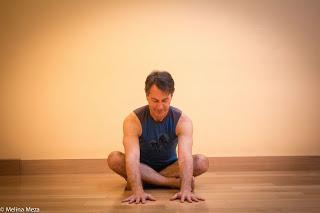 This version stretches the muscles and fascia around your hips and along the sides of your spine. Because it’s a forward bend, this version can be quieting and calming, helping reduce your stress levels. This version, however, is not suitable for meditation or breath practice.
This version stretches the muscles and fascia around your hips and along the sides of your spine. Because it’s a forward bend, this version can be quieting and calming, helping reduce your stress levels. This version, however, is not suitable for meditation or breath practice.To come into the pose, start in either version 1 or 2. Then, maintaining your straight back and inner lift, tip forward from your hips and place your hands or fingertips on the floor in front of you. When your hips stop rotating forward, you can allow your lower spine to round a bit. Come forward gradually until you feel a good stretch in your hips, along your spine, or both. If you feel any pain in your knees, hips, or lower back, try coming slightly out of the pose until the pain disappears. Once you are comfortable, bring your awareness to your breath.
Stay in the pose for 1-2 minutes or until your muscles begin to shake. To come out of the pose, walk your hands back as you lift your spine back into an upright position. Then change the cross of your legs and repeat the pose on the second side.
Subscribe to Yoga for Healthy Aging by Email ° Follow Yoga for Healthy Aging on Facebook ° Join this site with Google Friend Connect

